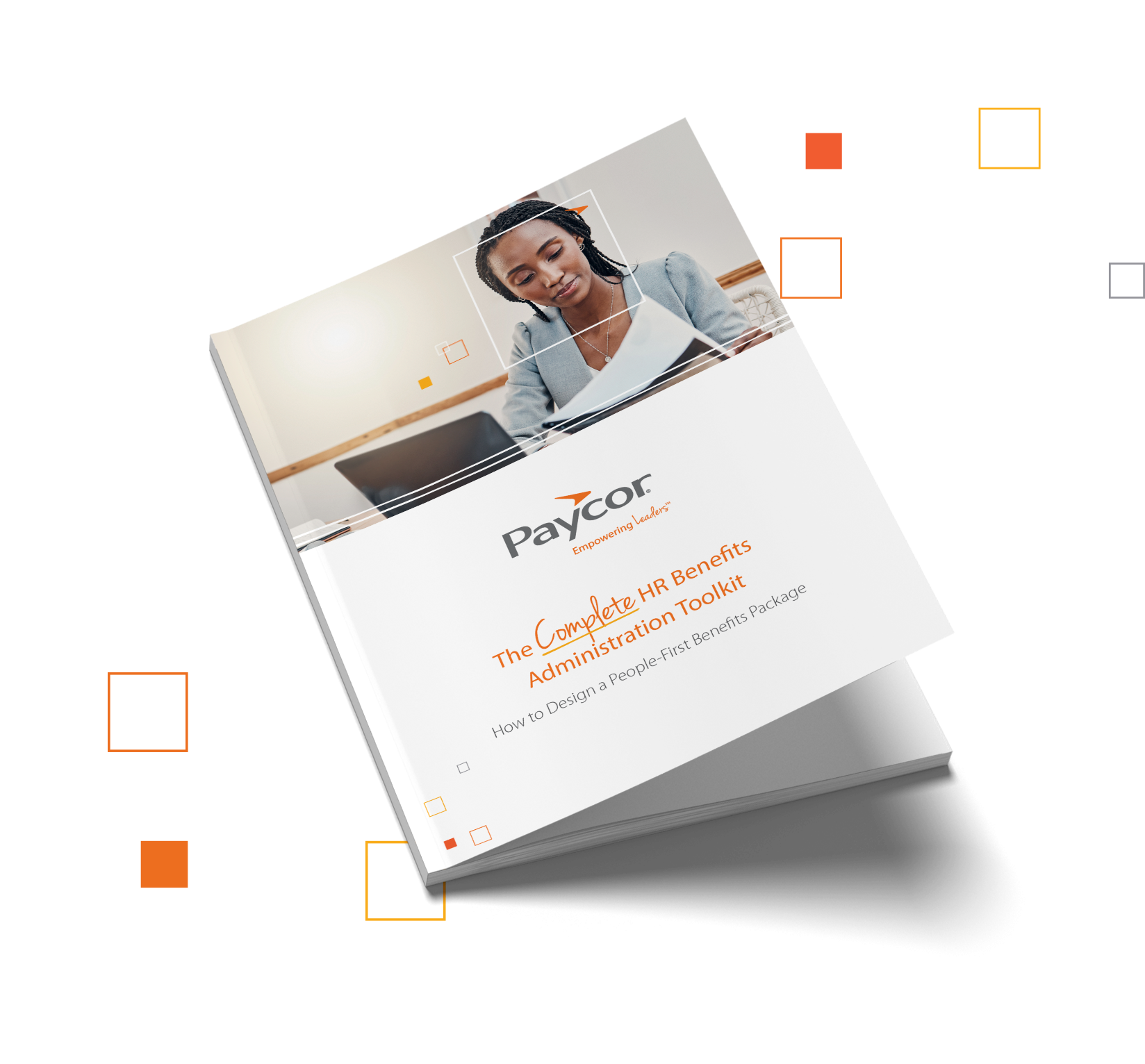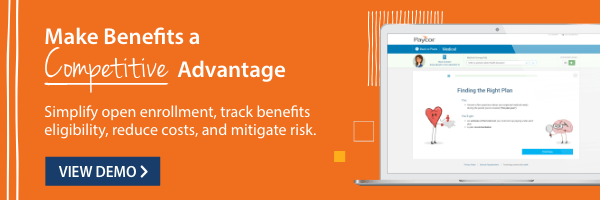At most companies, HR is responsible for handling benefits. You design a compliant benefits package, work with a broker to choose insurance companies and plans, and shepherd your team through open enrollment. HR also needs to understand several complicated, nuanced benefits-related questions. For example, what’s the difference between the Family and Medical Leave Act (FMLA) and disability leave?
Both short-term disability and FMLA offer support to employees during times of medical need. But there are several key distinctions. Ultimately, these two benefits serve different purposes. Understanding each one helps you stay compliant while supporting team members through challenging times.
What is Short-Term Disability?
Short-term disability insurance covers employees who are temporarily unable to work due to a medical issue. When that happens, they’ll receive benefits paid out by the insurance company. The exact benefits vary by insurance plan and provider, but typically include partial wage replacement for a pre-determined period, such as 30 days or one year.
Like any other insurance plan, certain conditions may or may not be covered. For example, some short-term disability insurance plans cover COVID-19, but only if a doctor confirms it’s severe enough to prevent you from working. Other plans may cover employees who miss work due to quarantine, even if they don’t have symptoms. Some plans cover maternity leave, and others don’t.
On a federal level, short-term disability insurance is not a mandatory benefit. However, it is mandatory in a few states, like New York and California (Social Security Administration). If your business is outside those areas, you can still offer this insurance as an added benefit. No matter where you’re located, HR should stay apprised of local and federal regulations to keep the company compliant.
What is the Family Medical Leave Act?
It’s important to understand the difference between FMLA and disability coverage. The Family Medical Leave Act (FMLA) is a federal law that gives eligible employees up to 12 weeks of unpaid leave per year without fear of losing their jobs (Department of Labor). In addition, some employees may benefit from state laws for paid family leave. On a federal level, employees can take FMLA leave for a variety of reasons, including but not limited to temporary medical conditions that render them unable to work.
For example, employees can also take FMLA leave for:
- Birth of a child (birthing or non-birthing parent)
- Placement of a child through adoption or foster care
- Serious health conditions
- Caring for family members with serious health conditions
- Military caregiver leave
FMLA leave is only available to eligible employees. This benefit is mandatory for certain organizations, including all public agencies, public elementary and secondary school employees, and all private employers with 50+ employees.
Differences Between Short-Term Disability vs. FMLA
| Short-term Disability | FMLA | |
|---|---|---|
| Purpose | Wage replacement | Job protection and unpaid leave |
| Duration | Typically 3-6 months | Up to 12 weeks per year |
| Eligibility | Varies by employer and plan | Employees with 1+ year of service and 1,250+ hours worked in the past year |
| Coverage | Medical conditions preventing the employee from performing work | Serious health conditions (employee or family member), childbirth, adoption, military family leave |
| Pay | Partial salary replacement | Unpaid (unless combined with other paid leave) |
| Job Protection | Not guaranteed | Guaranteed |
Purpose
Short-term disability serves as wage replacement during medical recovery. When an employee is unable to work for medical reasons, this insurance helps fill the financial gap.
FMLA provides job protection when an employee needs time off for family or medical reasons.
This is a form of legal protection, ensuring the employee’s job will still be available when they resolve the issue at home. FMLA does not provide financial compensation.
Duration
Short-term disability benefits typically last 3-6 months, with some policies extending up to one year, depending on the specific policy, medical condition, and other circumstances.
FMLA provides exactly 12 weeks of protected leave per rolling 12-month period. Federal FMLA is limited to 12 weeks regardless of condition severity, though some states offer additional family leave options.
Eligibility
Short-term disability eligibility is based on medical criteria and varies by employer and plan. Employees must have a qualifying medical condition that prevents them from working AND meet their specific policy’s other requirements.
FMLA eligibility has strict employment guidelines. Employees must have performed at least one year of service with their employer and must have worked 1,250+ hours in the past year. This only includes time actually worked; not sick leave or vacation days. FMLA leave is only mandatory for certain organizations. For example, private companies with fewer than 50 employees may not be required to provide this benefit.
Coverage
Short-term disability covers medical conditions that prevent the employee from performing their work duties. Coverage is limited to the policyholder’s personal health issues—not family health issues or non-medical life events—and varies significantly by insurance plan.
FMLA covers serious health conditions affecting the employee or their family members, childbirth, adoption, foster care placement, and certain military family situations. The scope extends beyond personal medical issues to family caregiving responsibilities.
Pay
Short-term disability provides partial salary replacement, typically covering a percentage of regular wages during the coverage period. This income replacement is the program’s primary function.
FMLA is unpaid leave, though employees can use accrued paid time off concurrently. FMLA itself provides no income replacement—the core benefit is job protection, not financial support.
Job Protection
On a federal level, short-term disability offers no guaranteed job protection. Despite this, many employers voluntarily hold positions open. Different states may also extend job protection in certain circumstances.
FMLA guarantees job restoration to the same or equivalent position with the same pay, benefits, and working conditions. This legal protection prevents termination for taking FMLA leave and ensures reinstatement upon the employee’s return.

Ready to Update your Benefits Package?
Get the tools you need to tailor your benefits package to your unique workforce. Check out our guide, The Complete HR Benefits Toolkit.
Employee Eligibility: Short-Term Disability vs. FMLA
To guide employees through the leave process, HR should understand the eligibility requirements for both FMLA and short-term disability. However, it’s important to remember that short-term disability requirements can vary widely between different U.S. states and specific insurance policies.
Conditions Qualifying for Both Programs
Serious surgeries, extended illness recovery, severe pregnancy complications, and major mental health episodes often qualify for both short-term disability and FMLA simultaneously, providing employees with both income replacement and job protection.
Short-Term Disability Only Scenarios
Medical conditions affecting employees who don’t meet FMLA’s strict employment requirements, minor surgeries with extended recovery periods, and pregnancy-related conditions not meeting FMLA’s “serious health condition” standard may qualify for disability benefits without FMLA protection.
FMLA Only Scenarios
Caring for seriously ill family members, bonding with healthy newborns, adjusting to adoption or foster care placement, and attending to military family emergencies qualify for FMLA leave without disability benefits, as these involve family care rather than personal medical conditions.
Employer Responsibilities: Short-Term Disability vs. FMLA
Employers have certain responsibilities when administrating short-term disability and FMLA benefits.
Short-Term Disability
If your company offers short-term disability insurance, your benefits administrator will have several key responsibilities. First and foremost, you’ll need to work with a broker or insurance provider to choose the appropriate plan. Make sure you understand which conditions are covered, which employees are eligible, and what documentation is needed to process claims.
HR is also responsible for communicating these details to the workforce, long before they need to make use of short-term disability benefits. This includes maintaining accurate payroll records for benefit calculations, coordinating with insurance carriers for claim approvals, and protecting employees’ medical information privacy.
FMLA
If your company is required to offer FMLA leave, HR has several mandatory responsibilities. You will need to:
- Give employees notice of their rights under FMLA, which may include posting FMLA notices in visible locations.
- Field employee requests for FMLA leave, responding to all requests within five business days.
- Determine employees’ eligibility for leave.
- Maintain accurate, updated records of each request, decision-making process, and approved leave.
- Continue to administer other benefits, like healthcare, while employees are on approved leaves of absence.
If HR fails to comply with FMLA regulations, your company will face serious legal and financial consequences.
Which Pays More, FMLA or Short-Term Disability?
This question reflects a common misunderstanding about these programs’ purposes. FMLA doesn’t pay anything—it’s unpaid, job-protected leave. Short-term disability is specifically designed for income replacement during medical conditions.
Employees often use both programs simultaneously. They take FMLA leave for job protection while receiving short-term disability benefits for income replacement. This combination provides comprehensive support during medical emergencies.
The real consideration is whether the short-term disability policy provides adequate income replacement. Most policies replace a percentage of salary, which may not cover all expenses during extended medical leave.
Short-Term Disability vs. FMLA: Which is Better for Business?
The answer depends on your workforce demographics, industry risks, and business priorities, but you should also consider the following:
Cost Management
Short-term disability involves direct premium costs but provides predictable income. As a result, budgeting is more straightforward for employees, and financial risk is transferred to insurance carriers. FMLA has no direct cost but creates indirect expenses for businesses through temporary replacement workers, training costs, and an increased administrative burden.
Employee Support Strategy
Offering short-term disability insurance demonstrates your financial commitment to employee well-being. FMLA is legally required for covered employers, making it a compliance requirement rather than a competitive advantage. Offering both programs provides comprehensive employee support, which can boost engagement, psychological safety, and retention.
Risk Mitigation
Short-term disability reduces the risk of employees working while impaired due to medical problems and financial pressure, which potentially prevents workplace accidents.FMLA reduces the risk of wrongful termination lawsuits and discrimination claims related to medical conditions.
How Paycor Helps with Short-Term Disability and FMLA
Paycor’s resources empower leaders to streamline every aspect of people management. Benefits administration doesn’t have to be a headache. Instead, HR leaders can use our Benefits Administration software to manage employee elections, changes, open enrollment, and other important details.
This tool gives managers and employees the support they need every step of the way—whether you’re navigating a regular workday, open enrollment, or a medical emergency. For example, Paycor’s platform helps track FMLA eligibility requirements, manage leave requests, and maintain proper documentation. These capabilities empower HR to improve the employee experience and avoid costly compliance mistakes.
Short-Term Disability vs. FMLA FAQs
Still have questions about short-term disability insurance and FMLA? Keep reading.
Are FMLA and Short-Term Disability the same?
No. FMLA provides unpaid, job-protected leave, while short-term disability provides income replacement without guaranteed job protection. They serve different purposes but can work together during medical emergencies.
What comes first, FMLA or Disability?
Neither comes “first”—they can run simultaneously. Employees often begin FMLA leave and short-term disability benefits at the same time for comprehensive protection while they deal with personal medical conditions
What Does Short-Term Disability and FMLA Cover?
Short-term disability covers certain employee medical issues that prevent them from performing work. It offers partial income replacement for qualifying conditions. FMLA covers serious health conditions, including medical issues that affect the employee and their family, as well as family care situations and military circumstances. FMLA offers job protection while the employee is on leave but provides no income replacement.
Can an Employee use both STD and FMLA at the same time?
Yes. This is common and often recommended. Employees receive short-term disability benefits for income replacement while taking FMLA leave for job protection, maximizing their security during medical recovery.
Do employers have to provide STD to employees?
No federal requirement exists for short-term disability. Five states (California, Hawaii, New Jersey, New York, Rhode Island) require disability insurance (Social Security Administration), but most employers offer it voluntarily as a competitive benefit.
Is short-term disability taxable?
Short-term disability insurance payments may or may not be taxable, depending on the premium payment method. If employees pay premiums with after-tax dollars, benefits are tax-free. If employers pay 100% of the premiums or employees use pre-tax dollars, short-term disability benefits are taxable income. Consult your tax advisor for specific situations.










